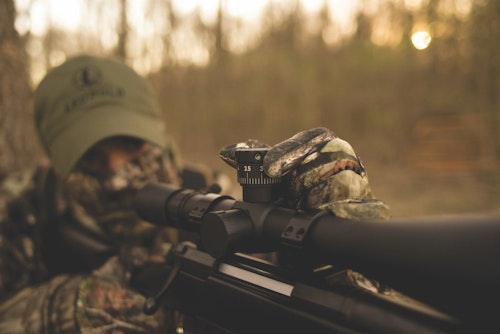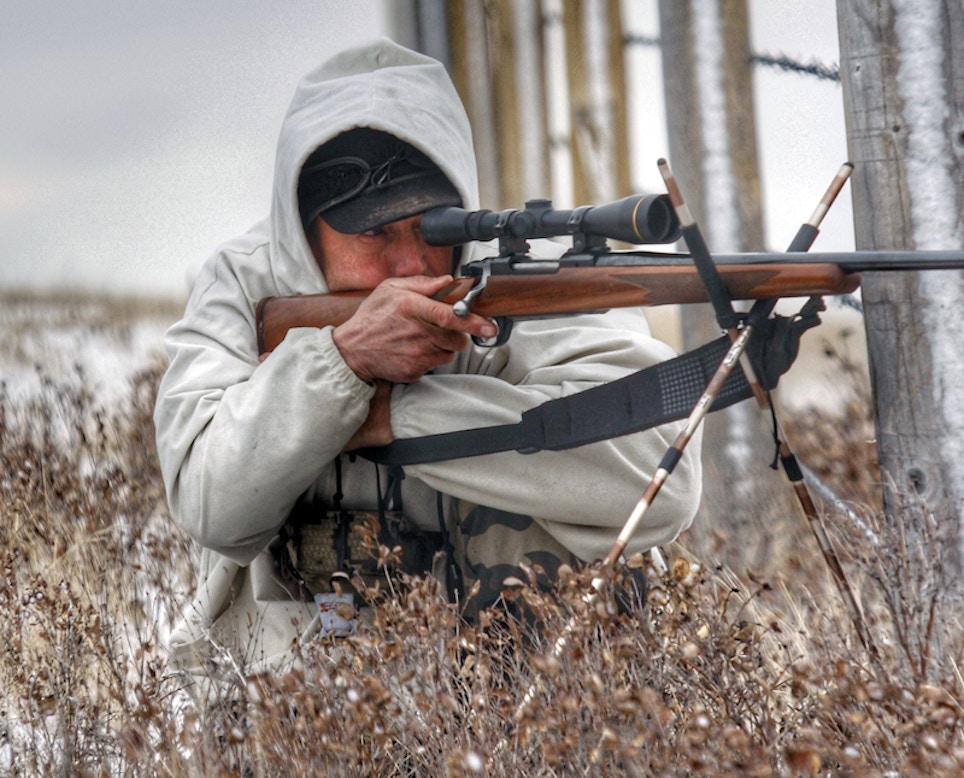I think it’s the diversity and idiosyncrasies of furred critters and the microenvironments they occupy that I find so compelling about hunting predators. No other pursuit demands a higher degree of determination and specialization when it comes to equipment. From various flavors of head-to-heel camo clothing, to terrain-specific boots, to special-purpose guns and ammo to a wide variety of sighting options, hunters must select the gear that precisely matches the hunt if they want to eke the most from each outing. This is especially true when it comes to sighting solutions.
Anyone who’s hunted predators with any degree of regularity, understands that things can, and often do, go south in a hurry. Hard-charging canines and felines arrive on the scene quickly and unannounced, and then disappear just as fast once they discover they’ve been duped. Instantaneous and accurate target acquisition is paramount to success, whether you’re hunting with a rifle or shotgun, and the hunter’s choice of optics — or the decision to not use optics — and how they are applied often determine how many critters end up in the fur shed at the end of the day. Sighting options not only need to match the firearm, but more importantly the type of terrain — and even the time of day or night — in which the hunting will take place.
Some hunters solve the dilemma of choosing between open sights and optics by carrying two guns — a scoped rifle and a shotgun. In more open areas, the shooter will typically sit with the rifle at the ready on a steady rest and the shotgun in his lap. Should a critter hang up at longer range he can end the drama with a well-placed shot from the rifle. Should it show up unexpectedly and close, he can ditch the rifle and take up the shotgun. The reverse is true in tight cover, where the shotgun will be the first line of offense and the rifle will serve as a backup.
Buddy hunters will often agree on diversity — one armed with a rifle, the other a scattergun. I recall one such hunt with my good buddy Gerry Blair some years back. Three hard-charging coyotes materialized from the yuccas at 30 yards, begging for rabbit, as Gerry liked to say. Gerry, armed with an Ithaca 10 gauge, had two of them rugged out before I could gather my wits. But I did manage to run down the straggler with my scoped .243 Win. as it escaped the wrath — and range — of the Mighty Ten. We scored a triple because we had the wherewithal to cover both bases.
One-gun hunters must decide between a rifle and shotgun based on terrain, and here sighting options become more critical. For tight, brushy country, a shotgun with open or aperture sights — or even a low- or no-magnification red-dot sight — will provide quick target acquisition and more consistent kills. My favorite choice for a shotgun is a peep (aperture) sight. The eye automatically centers the front sight in the center of the rear aperture, even a large one such as a Ghost Ring sight, and they can be surprisingly accurate. My older eyes have difficulty focusing traditional open sights because they tend to block out the lower portion of the field of view, and because of the depth of field limitations of the human eye, iron sights do not work as well for shooters with older eyes or poor vision.
An advantage of open sights — including aperture sights — is that the shooter can keep both eyes open when a critter responds to the call and avoid the tunnel vision that often accompanies shooting through a riflescope. This can be extremely helpful if multiple critters show up and follow-up shots are necessary. Low-magnification riflescopes, provide greater field-of view in these situations, too. This is the primary reason why they are preferred by dangerous game hunters, who need to keep their wits about them when on target.
In more open terrain, a variable-power scope atop a centerfire rifle is a better option. When I sit down to call, I generally keep my scope dialed to its lowest magnification unless I’m hunting in wide-open country where I can see for hundreds of yards in every direction. I figure I’ll have more time to crank the scope up if a critter hangs up and stares me down from 200 yards than crank it down should one bust out of the brush at a dead run 50 yards out.
The near fanatic popularity of AR-platform rifles and tactical shotguns among predator hunters opens the door to a host of sighting options, such as aperture sights, red-dot sights, low-power scopes with lighted reticles, etc. — and probably the coolest option for quick acquisition and low/no-light conditions, laser sights and night vision optics, which can be quickly and easily mounted on an AR or tactical shotgun’s rail system.
So let’s take a look at popular sighting options and what might be their best applications.

Open Sights: This is a bare-bones approach to target acquisition, and includes traditional iron sights and aperture sights, such as the popular Ghost Ring. With both eyes open the shooter avoids the tunnel vision that often accompanies shooting through a scope.
Best Application: Open sights give the scattergun shooter the ability to react quickly when predators show up unannounced. This is a great option when hunting where terrain and vegetation limits shots to 50 yards or less — such as high desert mesquite flats, big timber and frozen cattail sloughs. Open sights can also be used effectively while hunting at night with snow cover and the ambient light of a partial moon.
Red-dot sights: Available in low- and no-magnification models, red-dot sights are ideal for shotguns and rifles in relatively close quarters. They are also popular with AR-platform hunters. This sight provides positive target acquisition from awkward angles and can be adjusted for various light conditions — even the dark of the moon.
Best Application: These sights marry well with AR-platform rifles. They offer the shooter nearly instantaneous target acquisition and the ability to track a moving target without losing peripheral vision, allowing quick follow-up shots when multiple critters arrive on the scene. They also work great for shotguns, especially when hunting in semi-tight cover, or working the graveyard shift.
Fixed-power Scopes: Sometimes simplicity is best — as is the case with fixed-power scopes. The most common fixed-power magnification with fur hunters seems to be 6X, at least in my experience, which is ideal for a wide range of shooting — good for both close range (wide field of view) and moderate range (plenty of magnification). Those experienced hunters who use these scopes with regularity can quickly and accurately judge the distance to a critter by how large it appears in the scope — which is a constant because of its fixed power.
Best Application: To many hunters this might seem a bit old school, but in the hands of a seasoned fur hunter fixed-power scopes can be extremely effective. They offer no bells and whistles, so the hunter can concentrate on handling the critter, and not fidgeting with his optics. It takes a lot of the guesswork out and keeps things simple. Atop a flat-shooting rifle chambered in .22-250 Rem., this dog will hunt.

Variable-power Scopes: Probably the most popular of all riflescopes are those variable-power models seen on so many dedicated predator rifles. The operator can quickly dial up the amount of magnification desired for a wide variety of shooting situations. For fur hunters, those that fall roughly in the 3-12X magnification range are most common. Eastern hunters might get by with lower magnification, such as 2-7X or 3-9X, if most of their shooting will be at moderate range, say 200 yards or less. Western hunters, who like to stretch the barrels of their favorite fur guns, might opt for more power in the form of scopes that magnify 20 times or even more.
Best Application: These scopes are popular because of their versatility. Atop a good rifle they can be used in almost any situation and in any terrain. Just try not to get caught with your pants down. As I mentioned earlier, I keep my variable scope set at its lowest setting while calling in the likelihood that a critter might show up quickly at close range. Choose the amount of magnification to match the terrain.
BDC Scopes: BDC riflescopes with multiple-line reticles or dial-up turrets are all the rage these days — their manufacturers claiming they take all of the guesswork out of long-range shooting. These scopes utilize hash marks or adjustable turrets to remove the necessity of hold-over. The shooter sights-in at 100 yards and then either selects the hash mark that corresponds with a predetermined distance or dials the turret to pre-programmed yardages.
Best Application: Same application as standard variable-magnification scopes — except there will be no need to calculate hold-over at extreme ranges. Simply select the predetermined hash mark or dial the turret to the appropriate distance and tug the trigger. Those hunters who utilize these optics often have a yardage (dope) card taped to the stock of their rifle that they can “quickly” reference to select the proper hash mark or dial in the shot. Yes, BDC riflescopes perform as advertised — IF AND WHEN there is adequate time to quickly and accurately calculate range and select the proper setting while staying on target.
Laser Sights: For high-tech hunters, laser sights are a great option for the fast action inherent to calling critters. Models are available that can be used alone or in tandem with a riflescope. In concert with a scope they provide a redundant sighting reference that coincides with the scope’s crosshairs. Used without a scope — on an AR-platform rifle or tactical shotgun — they provide quick, intuitive target acquisition at close range, particularly in low-light situations.
Best Application: Again, quick target acquisition is the key here, and laser sights are a good choice for close to moderate ranges when shooting either shotguns or rifles. The laser draws the shooter’s eye to the “X” for quick and positive target acquisition, much like a scope with a lighted reticle.
Seasoned predator hunters know that things can and often do happen quickly when critters show up unexpectedly — that they might encounter fur targets at any conceivable range, and at every possible angle, from in their lap out to the horizon, and have to make quick shot decisions in the blink of an eye. And that’s why a considerable amount of thought should go into selecting the perfect sighting solution for each and every hunting situation.






